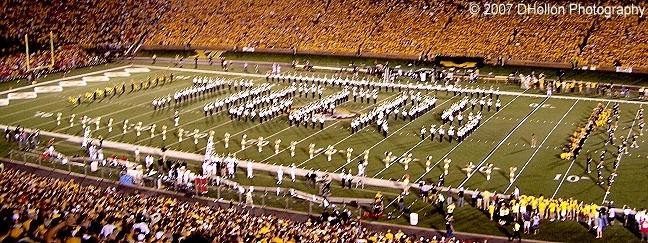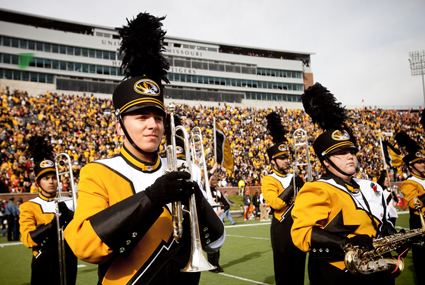Director Dr. Erin Cooper Active from 1885 | Founded 1885 (1885) Members 300 | |
 | ||
Fight song "Fight Tiger, Every True Son" Uniform Black shakos with plume, black overalls, gloves, and shoes, white jacket with black and gold striped collar, tilted golden 'M' runs down right arm creating a gold sleeve Similar Wildcat Marching Band, University of Arkansas, Spirit of Gold Marching, Million Dollar Band, Louisiana State University Profiles | ||
Marching Mizzou, M2, or The Big 'M' of the Midwest is the performing marching band for the University of Missouri, founded in 1885 as a college military band. Originally consisting of only 12 members, it is now the largest student organization on the MU campus, drawing students from nearly every major. Marching Mizzou performs at all home football games of the Missouri Tigers football team, in addition to other university events; a reduced band travels to the Tigers' away games, while the entire band regularly follows the team to conference championship games and bowl games. Marching Mizzou's signature drill "Flip Tigers" has been a well-known tradition of its pre-game show since 1960.
Contents
- Cadet Band
- Growing and opening up
- The Golden Girls
- Notable appearances
- M2 today
- Staff
- Pre game
- Bowl game appearances
- References

Cadet Band

Marching Mizzou began as the University of Missouri Cadet Band in 1885, founded by Frederick Pannell from the encouragement of Lt. Enoch H. Crowder. Initially, membership was limited to members of the school's Corps of Cadets. The band made only one appearance in the 1885 season, at a football game against the University of Kansas and was so well received by the assembled students and alumni that they were asked back to the next season's football games. The Corps obliged, and applications for membership grew quickly. Being a military band, the group performed at both Cadet Corps events and school events, playing music from composers like Beethoven and Wagner.
Growing and opening up

Under George Venable, director from 1910 to 1946, the band eventually moved away from military marching and acquired the characteristics of a show band. The big "M" formation debuted in 1934, and the band won highest honors in the Big 6 Conference that same year. Following the dissolution of the Corps of Cadets in 1944, membership was opened every male in the university and the group moved into the Department of Music under the direction of George Wilson. The band's first annual "High School Band Day" was held in 1945, inviting high schools to participate in a massed performance during half-time. In 1956, The University of Missouri Cadet Band split into a concert band, a university band, and the marching band, resembling its current structure. Charles Emmons became director in 1957, and under his direction women were allowed to join the band in 1958; most bands at the time remained male-only.
By 1966, over 50 bands and 4,000 students were participating in Band Day, requiring two sub-conductors to relay cues to the entire group.
The Golden Girls

In 1957, director Charles Emmons added a group of baton-twirling majorettes and two feature twirlers to the band. The group became known as the Golden Girls after purchasing now-iconic gold sequined uniforms in 1965. When Alexander Pickard became director in 1966, he began adding dancing to the Golden Girls' routines. For the next decade, the majorettes evolved into a dance team as their popularity across the campus grew. By the time they ceased carrying their batons in 1976, the group almost entirely was performing as dancers and only carried the batons out of tradition. The Golden Girls gradually became a separate entity from the band, while the few feature twirlers remained a part of Marching Mizzou. The Golden Girls were invited to perform at the Japan Classic after winning the 1991 NCA Collegiate Cheer and Pom Dance competition. They went on to win the same competition again in 1992 and 2003.
Notable appearances

Marching Mizzou was invited by President Truman to lead his Inaugural Parade in 1949; however, the Missouri legislature refused to fund the trip. As a consolation, the legislature allowed the band to march at the governor's inauguration in Jefferson City. M2 performed at Wembley Stadium in England in 1975 to 100,000 spectators. In January 2001, Marching Mizzou succeeded in traveling to Washington D.C. to perform in the inaugural parade for President George W. Bush. In March 2012, and then again in 2016, Marching Mizzou traveled to Dublin and Limerick, Ireland to perform in the St. Patrick's Day Parade and an International Marching Competition, respectively.
M2 today

Marching Mizzou today has near 300 band members, including a full color guard, a few feature twirlers, and a handful of drum majors. These drum majors serve as the top student leaders in M2, assisting in practices and with show design. The Golden Girls, under the coaching of Shannon Fry, work closely with the bands' leaders and attend two weekly practices with Marching Mizzou. Before every season, the band spends a week learning its unique pre-game show, preparing stands music, and starting on its half time shows. Since joining the Southeastern Conference, M2 now sends a (sometimes reduced) band to every away conference game.
Marching Mizzou has a wide repertoire of songs, ranging from older marches to classic and modern rock and hip-hop, in addition to the school's songs, and a few band favorites. Halftime shows are written around a particular theme, ranging from specific musical styles or groups. Nearly all of M2's music is written/arranged by faculty of the University of Missouri.
The MU Bands hosts three annual events for high schools. "M2 Band Day" brings in marching bands from across the state, to practice and perform with M2 at the season's first halftime. The pieces for the performance are often specifically composed to match a variety of experience levels. M2 also hosts a marching competition called "Champion of Champions" and a Homecoming Parade, both open to high school bands.
Select members of Marching Mizzou audition to form Mini Mizzou, a pep band founded in 1973 by Tim Lautzenheiser that attends other events on and around campus, including sporting events and requested appearances.
Staff
Pre-game
Marching Mizzou's pre-game show is a distinctive staple of the Tigers' football games. Some traditions have remained for decades, like the Block "M" and "Flip Tigers". Other parts of the show have changed, like forming the SEC logo since the Missouri Tigers joined the Southeastern Conference.
As of 2014, the band first runs onto the field and plays The New Missouri Fanfare '93. Next, it performs its unique "waltz-step" to the Missouri Waltz while in the Block "M" formation. It then forms a star shape to play The Star-Spangled Banner, followed by a flattening of the star; Tiger Rag, Eye of the Tiger, and Give a Cheer for Mizzou's Tigers! are performed. Until joining the SEC, Marching Mizzou had previously proceeded to form the outline of the state of Missouri with the letters "MU" in the lower half of the shape. Instead, it now forms the SEC logo. In this formation Marching Mizzou plays the alma mater of the University of Missouri, Old Missouri. Next, the band forms six columns on the field resembling the iconic columns of the Francis Quadrangle, while playing the first fight song, Every True Son.
The distinguishing "Flip Tigers" drill is then performed to MU's second fight song, Fight Tiger. The band sequentially forms the word "MIZZOU", then completes a rapid, 8-beat transition into the world "TIGERS". This move was created by director Charles Emmons and his assistant John Christie for the 1960 Orange Bowl. The band finally marches toward the South End-zone, forms a tunnel as the football teams runs on, then sprints off the field into the stands, completing their pre-game show.
Bowl game appearances
Marching Mizzou has supported the Mizzou Tigers at all of the following bowl games since the marching band was first founded, except for 1979:
